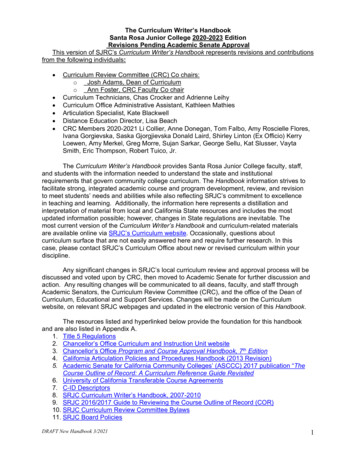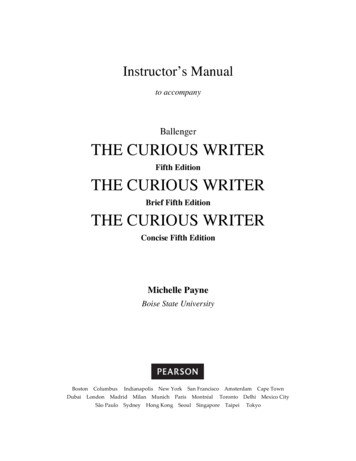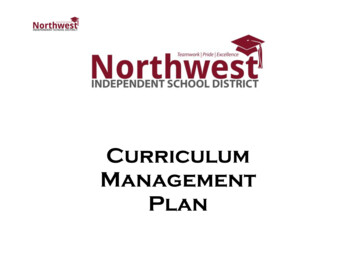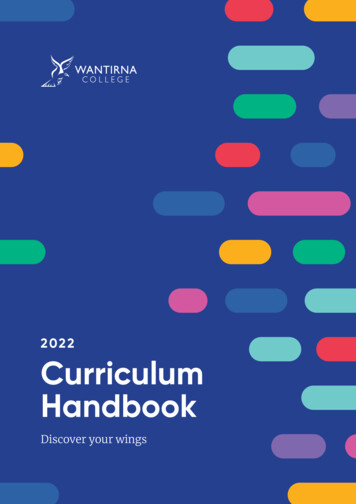
Transcription
The Curriculum Writer’s HandbookSanta Rosa Junior College 2020-2023 EditionRevisions Pending Academic Senate ApprovalThis version of SJRC’s Curriculum Writer’s Handbook represents revisions and contributionsfrom the following individuals: Curriculum Review Committee (CRC) Co chairs:oJosh Adams, Dean of CurriculumoAnn Foster, CRC Faculty Co chairCurriculum Technicians, Chas Crocker and Adrienne LeihyCurriculum Office Administrative Assistant, Kathleen MathiesArticulation Specialist, Kate BlackwellDistance Education Director, Lisa BeachCRC Members 2020-2021 Li Collier, Anne Donegan, Tom Falbo, Amy Roscielle Flores,Ivana Gorgievska, Saska Gjorgjievska Donald Laird, Shirley Linton (Ex Officio) KerryLoewen, Amy Merkel, Greg Morre, Sujan Sarkar, George Sellu, Kat Slusser, VaytaSmith, Eric Thompson, Robert Tuico, Jr.The Curriculum Writer’s Handbook provides Santa Rosa Junior College faculty, staff,and students with the information needed to understand the state and institutionalrequirements that govern community college curriculum. The Handbook information strives tofacilitate strong, integrated academic course and program development, review, and revisionto meet students’ needs and abilities while also reflecting SRJC’s commitment to excellencein teaching and learning. Additionally, the information here represents a distillation andinterpretation of material from local and California State resources and includes the mostupdated information possible; however, changes in State regulations are inevitable. Themost current version of the Curriculum Writer’s Handbook and curriculum-related materialsare available online via SRJC’s Curriculum website. Occasionally, questions aboutcurriculum surface that are not easily answered here and require further research. In thiscase, please contact SRJC’s Curriculum Office about new or revised curriculum within yourdiscipline.Any significant changes in SRJC’s local curriculum review and approval process will bediscussed and voted upon by CRC, then moved to Academic Senate for further discussion andaction. Any resulting changes will be communicated to all deans, faculty, and staff throughAcademic Senators, the Curriculum Review Committee (CRC), and the office of the Dean ofCurriculum, Educational and Support Services. Changes will be made on the Curriculumwebsite, on relevant SRJC webpages and updated in the electronic version of this Handbook.The resources listed and hyperlinked below provide the foundation for this handbookand are also listed in Appendix A.1. Title 5 Regulations2. Chancellor’s Office Curriculum and Instruction Unit website3. Chancellor’s Office Program and Course Approval Handbook, 7th Edition4. California Articulation Policies and Procedures Handbook (2013 Revision)5. Academic Senate for California Community Colleges’ (ASCCC) 2017 publication “TheCourse Outline of Record: A Curriculum Reference Guide Revisited6. University of California Transferable Course Agreements7. C-ID Descriptors8. SRJC Curriculum Writer’s Handbook, 2007-20109. SRJC 2016/2017 Guide to Reviewing the Course Outline of Record (COR)10. SRJC Curriculum Review Committee Bylaws11. SRJC Board PoliciesDRAFT New Handbook 3/20211
The handbook is divided into six sections, a glossary, and six appendices. Each section’spurpose is briefly summarized below.1. Section One explains roles and responsibilities of the Curriculum ReviewCommittee (CRC), Cluster Tech Review Committees (CTRC), CRCsubcommittees (e.g., General Education), and the Curriculum Office.2. Section Two outlines Title 5 and Chancellor's Office regulations and standardsfor all community college course types.3. Section Three outlines course development and revision requirements andprocesses.4. Section Four defines each component of SRJC’s Course Outline of Record(COR) and guidelines for developing, revising or reviewing CORs.5. Section Five explains requirements for development and review of programs,including occupational majors, transfer majors, and certificate types.6. Section Six provides additional information regarding courses requiring specialconsiderations, such as transfer and distance education.7. Glossary lists relevant terms and phrases and their abbreviations whenappropriate. When a term or phrase is first used, it is spelled out fully followed byits abbreviation in parentheses. After this initial use, the abbreviation will be usedexcept in headings and subheadings where term is spelled out.8. Appendices-Each appendix has its own purpose, which is summarized at the topof each appendix.DRAFT New Handbook 3/20212
The Curriculum Writer’s HandbookTable of Contents1 Introduction to Curriculum Review Structure1.1Curriculum Review Committee Function and Composition1.2Curriculum Review Committee Responsibilities1.3Curriculum Office Responsibilities1.4Cluster Tech Review Committee Composition & Responsibilities1.5Curriculum Review Committee Subcommittees & Responsibilities1.6Degree of Course Change, Review, and Status2 California State Requirements for Course Approval2.1Basic Criteria for Approval2.2Associate Degree Credit Course Standards2.3Non-Degree Credit Course Standards (Numbers 300-399)2.4Noncredit Course Standards (Numbers 400-799)2.5Standards for Stand-Alone Courses2.6The Course Outline of Record as a Legal Document3 The Curriculum Development and Approval ProcessFlow Chart of the Curriculum Development and Approval Process3.1Initial Steps in Course Development or Revision3.2Writing the Course Outline of Record3.3Submission, Cluster Tech Review and CRC Subcommittees3.4Curriculum Review Committee Actions and Follow-Up4 Components of the Course Outline of Record4.1The Integrated Course Outline4.2Term Effective Date4.3Prefix and Course Number4.4Course Titles4.5Hours, Units, Weeks4.6Title 5 Categories and Grading:4.7Repeatability4.8Course Descriptions for Catalog and Schedule of Classes4.9Prerequisites, Corequisites, & Recommended Preparation4.10Articulation, Major, and Certification Information4.11Student Learning Outcomes and Course Objectives4.12Topics and Scope4.13Assignments4.14Methods of Evaluation and Basis for Assigning Grades4.15Representatives Textbooks5 Certificates and Majors5.1Types of Certificates5.2Majors (Occupational and Transfer Degree Programs)5.3Program Development and Proposal Process5.4Revisions to Certificates and Majors6 Additional Information about Courses6.1About Transfer Courses6.2Special Topics and Experimental Courses (48, 98, 148, etc.)6.3Courses Numbered 48 (Special Topics) and 49 (Independent Study)DRAFT New Handbook 3/20213
6.46.56.66.76.86.96.10Independent Studies Courses (98)About General Education CoursesAbout Noncredit Courses (400-799)Distance EducationAbout Stand-Alone CoursesCurriculum Database SystemSupport for Curriculum Development and ApprovalGlossaryAppendicesAppendix AAppendix BAppendix CAppendix DAppendix EAppendix FList of Resources for Handbook InformationResources for Writing SLOs and Course ObjectivesVarious Ways to Access Course Outline of RecordEffective Practices for Cluster Tech Review CommitteesChecklist for Writing/Revising Course Outline of RecordFormsDRAFT New Handbook 3/20214
Section 1 Overview of Curriculum Review Structure1.1 Curriculum Review Committee Function and CompositionTitle 5 requires that all courses and programs be approved first by a college committee:§55002 The committee shall be either a committee of the Academic Senate or a committeethat includes faculty and is otherwise comprised in a way that is mutually agreeable to thecollege and/or district administration and the academic senate.ASCCC explains that“The curriculum committee reviews and recommends courses and programs functioningunder policies and procedures set by the Academic Senate (either through primary advice toor mutual agreement with the board). The composition of the curriculum committee isagreed upon mutually even if the board relies primarily upon the Senate for other curriculumpolicies and procedures. The board approves courses and programs recommended directlyby the curriculum committee and with the assurance of the Academic Senate thatestablished policies and procedures have been reviewed and followed.”At SRJC, this committee is known as the Curriculum Review Committee (CRC). TheAcademic Senate appoints the faculty representatives, the college president appoints theadministrative representatives, and some members are on the committee by position. TheCRC is both an Academic Senate Standing Committee and an Academic SenateConsultation Committee that has a close reporting and consulting relationship with theAcademic Senate. CRC follows its bylaws approved by Academic Senate.The CRC’s official membership includes 22 members, 20 of whom are voting members: 15 facultyo 14 appointed by Academic Senateo 1 Transfer Center DirectorDeanso 1 appointed by Academic Affairso 1 Curriculum Deano 1 Senior Dean, Counseling and Student Success or designeeo 1 Dean (or management), Admissions & Enrollment Services or designee1 Articulation Specialist (classified, by position)2 students, appointed by student government2 ex-officio (non-voting) o 1 from the Assessment Officeo 1 from the Distance Education OfficeThe CRC is co-chaired by the Curriculum dean and a faculty member elected by the committeeaccording to CRC Bylaws.The CRC meets every 2nd and 4th Monday during the academic year, 3:15-5:15 p.m.Periodically, additional meetings are scheduled when extra time is needed for course and/orprogram approval. The agendas, minutes, and current locations of meetings are accessible viaSRJC’s Curriculum website. CRC meetings are open to all members of the college community.CRC bylaws state “All actions taken by the Curriculum Review Committee are subject to reviewby the Academic Senate." Monthly reports plus an annual summary of CRC actions arepresented to the SRJC Board of Trustees.1.2 Curriculum Review Committee (CRC) ResponsibilitiesA. The CRC is charged with ensuring that all courses and programs meet the standards forapproval stated in Title 5 and the Chancellor’s Program and Course Approval Handbook, 7thDRAFT New Handbook 3/20215
edition. CRC: Recommends approval of all new and revised courses, including online courses;Recommends approval of all new and revised Programs of Study;Recommends approval of CRC subcommittees’ suggestions;Ensures each Cluster Tech Review Committee (CTRC) includes a CRC representativewho serves as CTRC co chair;Interprets and communicating all curriculum standards and requirements to the collegecommunity;Creates and maintaining forms and processes for course approval including distanceeducation offerings (e.g., Emergency DE form)Consults with faculty who are developing and revising courses and programs;Facilitates discussion and decision-making regarding curriculum at SRJC; andMaintains clear communication with the Academic Senate.B. CRC Co chairs shared responsibilities are listed below. For a complete list of each chair’sresponsibilities, see CRC Bylaws. Preparing and distributing each CRC agenda, including which courses must appear onAction Items agenda and which ones are eligible for Consent Agenda; Voting at meetings; Staying informed of curriculum standards as stated in Title 5, the Chancellor’s OfficeProgram and Course Approval Handbook, and the regional accrediting body; and Assuring that committee functions take place smoothly, including: Cluster Tech Review;prerequisite and recommended preparation review (through Content Review); DistanceEducation (DE) review; General Education (GE) review; sign-off by the Dean of LearningResources and Educational Technology, Library and Information Resources; andarticulation.1.3 Curriculum Office ResponsibilitiesThe responsibilities of the Office of Curriculum and Educational Support Services (referred to asthe “Curriculum Office” throughout this handbook) and the Curriculum Dean include: Managing submission of proposed and revised course outlines, distribution of courseoutlines to committees, and follow-up after approval of proposed coursesKeeping records of all CRC agendas and actions;Identifying and communicating new information and laws from the State level to theCRC, deans, and other college bodies; andSubmitting course and program information and forms as required by the State.1.4 Cluster Tech Review Committee (CTRC) Composition and ResponsibilitiesThese committees are composed of members from each cluster. Each group reviews new andrevised Course Outlines of Record (CORs) from disciplines within the cluster before the CORgoes on the CRC agenda.A. Composition. A Cluster Tech Review Committee includes:1. A CRC faculty member, who serves as co-chair;2. The dean of the cluster, who serves as the other co-chair;3. An adequate number of faculty representing the different disciplines within a givencluster (approximately 2-5, depending on the cluster); and4. Classified staff, usually the dean’s administrative assistant, for administrative supportB. Responsibilities. The CTRC reviews each new and revised COR for departments withinDRAFT New Handbook 3/20216
that cluster. Specifically, this committee:1. Ensures that the course meets the standards spelled out in this Handbook for format,compliance, content, clarity, rigor, completeness, and correctness;2. Reviews the feasibility and alignment of the Student Learning Outcomes (SLOs) with thecourse objectives, using the guidelines in this Handbook;3. Ensures that the course demands critical thinking, and, for CSU and UC transfer-levelcourses, demonstrates appropriate rigor;4. Records comments and recommendations for changes on a Cluster Tech ReviewFeedback form (Appendix F), which is given to the submitter. Ideally, the submitter willattend the CTRC meeting when the course is reviewed and will receive feedbackfirsthand and make changes at the CTRC meeting; and5. Acts as a resource for instructors to discuss ideas for creating or revising courses beforeformally writing them.1.5 Curriculum Review Committee (CRC) and Subcommittees & ResponsibilitiesSeveral subcommittees support the functions of the CRC. Membership on these committees isoutlined in CRC bylaws.A. The General Education Subcommittee. This committee reviews courses that have beensubmitted for approval under any of the three general education patterns: Associate Degree (Option A, except for Areas G, H, and I); CSU (Option B); or IGETC (Option C).All GE proposals must go through the GE Subcommittee and be approved by the full CRC. Formore on General Education, see Section 6.B. Distance Education Advisory Committee (also known as: DE Reviewers Review DE proposals and course compliance with Title 5 regulations for DE delivery. Consult with submitting faculty on any changes to DE course or proposal Discuss course DE proposal, and recommend DE delivery for approval on CRC ConsentAgendaC. Majors & Certificate Review Committee (MCRC): Technically, this committee isboth an Academic Senate and advisory committee to Education Planning (EPCC).The MCRC reviews all applications for new programs requesting or requiringChancellor’s Office approval. MCRC works with the department until the proposal for amajor/certificate is ready for recommendation and forwarding to the CRC for approval.The MCRC: Reviews the application for completeness and accuracy and Ensures that Transfer Model Curriculum (TMC) templates comply with Chancellor’sOffice accepted templates and policies.1.6 Degree of Course Change, Review, and StatusThis section outlines categories of revision and criteria for a “full review” in the course revisioncycle. When considering substantial revisions, refer to chart below to determine whether thechanges might require creating a new course.DRAFT New Handbook 3/20217
Full Review(Requires Cluster Tech Review; 6-year review cycle updated)New Course: Action Agenda (Contact Curriculum Office)If the focus and purpose of the course changes significantly, then a new course is recommendedrather than a revision. Additionally, if a course significantly changes due to new scholarship, trends inthe field, or evolving technologies, a new course may be required.Course Outline of Record SectionUnit Value ChangeHoursCOR ContentCourse split (or merge)Changes/Revisions- Varies by course level and context; see notebelow chart about Unit Value Changes.- If the units of a UC transfer level course decrease,seek guidance from the Curriculum Office andArticulation OfficerIf a lecture/lab course becomes lecture- or lab-only, orvice versaElements in the COR have been changed to such adegree that the course is essentially a differentcourse.A semester course is broken into separate modules.ORTwo or more short, related courses are combined tomake a semester length course.Major Change: Action Agenda(ASCCC page 51)Course Outline of Record SectionCourse ReviewUnitsHoursNumber of RepetitionsPrerequisites, Corequisites, RecommendedPreparationLimits on Enrollment (LOE)SLOsObjectivesCourses StatusCourse LengthDRAFT New Handbook 3/2021Change/Revision6-year review cycle updatedChange in configuration or total number of unitsChange in configuration or total number of hoursChange in number of repetitionsChange in prerequisites, corequisites, and/orrecommended preparation (Title 5, §55200);Revision or addition of LOEAddition/Removal/Revision of SLOs that represent amajor change to course.Addition/Removal/Revision of objectives thatrepresent a major change to course.Change in credit/noncredit statusChange in term length into a compressed timeframe8
Minor Change: Consent AgendaCourse Outline of Record SectionChanges/RevisionsCourse last reviewed 6 years or earlier6-year review cycle updatedPrefix/Course Number/TitleChanges in course number or title for courses inprograms require submission of program revisionform to Curriculum OfficeProgram ApplicableCourse DescriptionSLOsObjectivesTopics and ScopeAssignmentsMethods of EvaluationTextbooksOtherMinor revisions to Catalog Description to increaseclarity and transparency.Minor Revision to SLOs (e.g., word choice, combiningtwo SLOs into one)Minor Revision to Objectives (e.g., word choice,combining Objectives, breaking one objective intotwo)Minor Revisions to Topics and Scope (e.g., wordchoice)Minor Revisions to Assignments (e.g., word choice)Minor Revisions to Methods of Evaluations (e.g., wordchoice)Updating edition of texts1. Addition of a focus area to a currently approvedSpecial Topics umbrella course.2. Adding Distance Education as a mode of deliveryModification/Technical Correction(Does NOT require Cluster Tech; 6-year review cycle will NOT be updated)Course Outline of Record SectionPrefix / Course NumberTitleProgram ApplicableCourse DescriptionIf revisions are minimal, and/or occur in only oneSLOssection, then CRC Co-Chairs may recommend aObjectivesmodification rather than full reviewTopics and ScopeAssignmentsMethods of EvaluationTextbooksTypographical or grammaticalCorrections of errorsCodingMost coding changes (not part of COR Content) canbe modification items. Examples are: Changing Major or Certificate status Changes in TOP or SAM CodesNOTES:1. If any of these sections are changing AND the course is part of a Certificate or Major, then aProgram Revision form is necessary.2. Unit Value Changes: Due to the specific requirements and policies of external bodies, suchas UCOP, Title 5, C-ID, GE, CSU, CCCCO, etc, a unit change might require a new coursenumber and title or it might not. Before starting either a new or revised course proposal, emailCRC Co-Chairs, Curriculum Technicians, and Articulation Officer with a request for Unit ValueChange and a simple rationale statement. This allows for guidance on how to proceed throughthe course approval process while still following relevant requirements and policies for thatspecific course.DRAFT New Handbook 3/20219
Section 2 California State Requirements for Course ApprovalThis section summarizes regulations for the course approval process. Programdevelopment and approval is covered separately in Section 5.2.1 Basic Criteria for ApprovalAll courses and programs must meet the five basic criteria for approval stated in Title 5, assummarized below by the Chancellor’s Office PCAH, 7th Edition, pages 24-28. Courses beingapproved for inclusion in a Transfer Model Curriculum (TMC) must meet additional criteria. (SeeSection 6)A. Appropriateness to mission. Course must be directed at the appropriate level for communitycolleges; must address a valid transfer, occupational, basic skills, civic education, or lifelonglearning purpose; and must provide distinct instructional content and specific instructionalobjectives.B. Need. Must provide evidence of need for the course in college service area.C. Quality (Curriculum Standards). Must fulfill the requirements of the local curriculum approvalprocess, which includes careful scrutiny by college’s curriculum committee; approval withinthe local district as well as on a regional level (occupational); course should also beconsistent with requirements of accrediting agencies.D. Feasibility (Adequate Resources). The college has the resources needed to offer thecourse at the level of quality described in the COR.E. Compliance. Design of the course or program is not in conflict with any law, including bothstate or federal laws, and both statutes and regulations.2.2 Associate Degree Credit Course StandardsAll credit courses must meet the following standards, as outlined in Title 5, §55002. The wordingbelow comes directly from the most recent version of Title 5, §55002.A. Grading Policy. The course provides for measurement of student performance in terms of thestated course objectives and culminates in a formal, permanently recorded grade based uponuniform standards in accordance with section 55023. The grade is based on demonstratedproficiency in subject matter and the ability to demonstrate that proficiency, at least in part, bymeans of essays, or, in courses where the curriculum committee deems them to be appropriate,by problem solving exercises or skills demonstrations by students.B. Units. The course grants units of credit in a manner consistent with the provisions of section55002.5. The course outline of record shall record the total number of hours in eachinstructional category specified in governing board policy, the total number of expected outsideof-class hours, and the total student learning hours used to calculate the award of credit.C Intensity. The course treats subject matter with a scope and intensity that requires students tostudy independently outside-of-class time.D. Prerequisites and Corequisites. Except as provided in section 55522, when the collegeand/or district curriculum committee determines, based on a review of the course outline ofrecord, that a student would be highly unlikely to receive a satisfactory grade unless the studenthas knowledge or skills not taught in the course, then the course shall require prerequisites orcorequisites (credit or noncredit) that are established, reviewed, and applied in accordance withDRAFT New Handbook 3/202110
the requirements of this article.E. Basic Skills Requirements. If success in the course is dependent upon communication orcomputation skills, then the course shall require, consistent with the provisions of this article, asprerequisites or corequisites eligibility for enrollment in associate degree credit courses inEnglish and/or mathematics, respectively.F. Difficulty. The course work calls for critical thinking and the understanding and application ofconcepts determined by the curriculum committee to be at college level.G. Level. The course requires learning skills and a vocabulary that the curriculum committeedeems appropriate for a college course.2.3 Non-degree Credit Course Standards (Numbers 300-399)All non-degree credit courses must meet specific standards similar to those for AssociateDegree credit courses (see above and Title 5, §55002). The assignments will be sufficientlyrigorous that students completing each noncredit course successfully will have acquired theskills necessary to successfully complete degree-applicable work upon the requiredsequence of such courses. The types of courses that are non-degree applicable creditcourses include: Non-degree applicable basic skills courses;Courses designed to enable students to succeed in degree-applicable credit courses that integrate basic skills instruction throughout and assign grades partly upon thedemonstrated mastery of those skills;Pre-collegiate career technical preparation courses designed to provide foundation skillsfor students preparing for entry into degree-applicable credit career technical courses orprograms; andEssential occupational courses for which meeting the standards of [the above] areneither necessary nor required.2.4 Noncredit Course Standards (Numbers 400 and above)A. Noncredit Courses in General. According to §55002, a noncredit course is one that: “treatssubject matter and uses resource materials, teaching methods, and standards of attendanceand achievement that the committee deems appropriate for the enrolled students.” Thesecourses are limited to categories listed in Title 5, Section 58160:1. Parenting, including parent cooperative preschools, classes in child growth anddevelopment and parent-child relationships;2. Elementary and secondary basic skills;3. English as a second language;4. Classes and courses for immigrants eligible for educational services;5. Education programs for persons with substantial disabilities;6. Short-term vocational programs with high employment potential (includesapprenticeships);7. Education programs for older adults;8. Education programs for home economics (known as Family and Consumer Sciences);and9. Health and safety education.Supervised tutoring is a course option under each of the 9 areas.B. Noncredit Courses Eligible for Enhanced Funding. Title 5 allows certain types ofDRAFT New Handbook 3/202111
noncredit courses to receive enhanced funding. These courses must be part of either: A short-term vocational program OR A sequence focusing on elementary and secondary basic skills, workforce preparationcourse in basic skills, English as a Second Language (ESL), or Vocational English forSpeakers of Other Languages (VESL).The program or sequence must result in either: A noncredit certificate of completion leading to improved employability or job opportunity;orA noncredit certificate of competency in a recognized career field articulated withdegree-applicable coursework, associate degree, or bachelor's degree.All noncredit courses must be approved by the Chancellor’s Office. For more informationabout noncredit courses, see Section 6.7 and/or contact SRJC’s Curriculum Office.2.5 Standards for Stand-Alone CoursesMost SRJC courses are part of a program of study including: Skills Certificates;Certificates of AchievementAssociate in Arts (AA) degreesAssociate in Science (AS) degrees andAssociate Degree for Transfer (ADT) degrees.These programs, except for Skills Certificates, require Chancellor’s Office approval. A standalone course is a credit course that is not part of a Chancellor’s Office approved program. Forexample, if a course is part of a skills certificate, and not part of another Chancellor’s Officeapproved program, despite being in a locally approved program, it is considered a stand-alonecourse. SRJC has various stand-alone courses because they meet the standards defined in 2.12.3 and fulfill purposes within the college’s mission.Examples of current stand-alone courses are: Transfer-level courses that fulfill UC or CSU General Education requirements, but notSRJC patterns;Transfer-level courses that fulfill UC or CSU major requirements, but not SRJC majors;Courses that are part of Skills Certificates (not approved by Chancellor’s Office) under16 units;Non-degree-applicable skills courses in math, English, or occupational areas; andPublic Safety courses that provide ongoing training for Public Safety employees.2.6 The Course Outline of Record (COR) as a Legal DocumentTitle 5 requires that every course be represented by a (COR), an official public documentapproved by a curriculum committee and local board, and, usually, the Chancellor’s Office,which must approve all courses associated with programs and all noncredit courses. The CORmust meet all Title 5 standards. Furthermore, the Course Outline of Record: States the Student Learning Outcomes, Objectives, content, and level of rigor for whichstudents and faculty—across all sections of the course—will be held accountable; Provides the basis for determining the degree of preparation (prerequisites, corequisites,DRAFT New Handbook 3/202112
and/or recommended preparation) that students need to advance successfully through aseries of courses; Ensures consistent, quality instruction (from instructor to instructor, section to section,and year to year) by clearly identifying standards and content of the course while stillproviding flexibility for individual instruction. “Curriculum approval at the local level playsa central role in ensuring that all students receive the same quality of instruction” (PCAH,7th Edition page 53); Plays a critical role in the college’s ongoing program review process that aims to keepSJRC’s curriculum relevant and sufficiently allocate resources to maintain the college’sprograms and courses; Demonstrates that all the required components are present in the course to the requireddegree of rigor as specified in Title 5; and Serves as documentation of the college's high academic standards and quality foraccreditation.Also, the Course Outline of Record is an essential element in the transfer process because it: Is submitted for approval as meeting California State University General Education(CSU/GE) breadth requirements and for inclusion in the Intersegmental GeneralEducation Transfer Curriculum (IGETC), and/or may be part of a TMC; and Is t
SRJC Curriculum Writer's Handbook, 2007-2010 9. SRJC 2016/2017 Guide to Reviewing the Course Outline of Record (COR) 10. SRJC Curriculum Review Committee Bylaws 11. SRJC Board Policies . DRAFT New Handbook 3/2021 2 The handbook is divided into six sections, a glossary, and six appendices. Each section's










